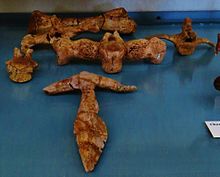Simoedosaurus
| Simoedosaurus | |
|---|---|

| |
| Fossil | |
| Scientific classification | |
| Domain: | Eukaryota |
| Kingdom: | Animalia |
| Phylum: | Chordata |
| Class: | Reptilia |
| Order: | †Choristodera |
| Suborder: | †Neochoristodera |
| Genus: | †Simoedosaurus Gervais, 1877 |
| Type species | |
| †Simoedosaurus lemoinei Gervais, 1877
| |
Simoedosaurus is an extinct reptile known from the Paleocene of North America, Europe and western Asia,[1] and a member of the Choristodera, a group of aquatic reptiles that lived in the Northern Hemisphere from the Jurassic to the early Cenozoic.
A second species, S. dakotensis got its own genus, Kosmodraco, in 2022.[2]
Taxonomy
[edit]French paleontologist Paul Gervais described Simoedosaurus in 1877.
Though similar to and contemporaneous, Simoedosaurus is not closely related to the North American Champsosaurus, instead it appears to be most closely related to Tchoiria and Ikechosaurus from the Early Cretaceous of Asia. It therefore may represent a species that immigrated into North America from Asia in the wake of the Cretaceous-Tertiary mass extinction event, though the absence of choristoderes in the Late Cretaceous of Asia makes this merely a paleogeographical speculation.[3]
Biology
[edit]Simoedosaurus was an aquatic predator, specialised to a fully aquatic lifestyle; though Champsosaurus might have still come ashore to lay eggs, ovovivipary is known in other choristoderes.[4] It in particular possesses broader, stronger jaws than other longirostrine choristoderes, including its closest relatives, suggesting that it was capable of tackling larger prey.[5]
Simoedosaurus does occur in sites where aquatic crocodilians are present, including brevirostrine forms like Borealosuchus; the extent of competition between both groups, if there was any, is still unresolved.[6]
Like other neo-choristoderes it has nasal conchae, suggesting it could regulate its own body temperature, explaining its ability to live in cold waters.[7]
Range
[edit]The earliest records of Simoedosaurus are from the Early Paleocene (Puercan Land Mammal Age) of Saskatchewan. It persisted until the Late Palaecene in North America, and has also been found in the Late Paleocene of France. The youngest remains seem to occur in the Eocene of Kazakhstan.[8]
References
[edit]- ^ Averianov AO (2005). "The first choristoderes (Diapsida, Choristodera) from the Paleogene of Asia". Paleontological Journal. 39 (1): 79–84.
- ^ Brownstein CD (March 2022). "High morphological disparity in a bizarre Paleocene fauna of predatory freshwater reptiles". BMC Ecology and Evolution. 22 (1): 34. doi:10.1186/s12862-022-01985-z. PMC 8935759. PMID 35313822.
- ^ Matsumoto R, Evans SE (2010). "Choristoderes and the freshwater assemblages of Laurasia". Journal of Iberian Geology. 36 (2): 253–274. doi:10.5209/rev_JIGE.2010.v36.n2.11.
- ^ Ji Q, Ji SA, Lu J, You H, Yuan CX (2006). "Embryos of Early Cretaceous Choristodera (Reptilia) from the Jehol Biota in western Liaoning, China". Journal of the Paleontological Society of Korea. 22 (1): 111–118.
- ^ Matsumoto R, Evans SE (March 2016). "Morphology and function of the palatal dentition in Choristodera". Journal of Anatomy. 228 (3): 414–29. doi:10.1111/joa.12414. PMC 5341546. PMID 26573112.
- ^ R. Matsumoto and S. E. Evans. 2010. Choristoderes and the freshwater assemblages of Laurasia. Journal of Iberian Geology 36(2):253-274
- ^ Dudgeon TW (2019). The internal cranial anatomy of Champsosaurus lindoei and its functional implications (Doctoral thesis). Carleton University.
- ^ Averianov AO (2005). "The first choristoderes (Diapsida, Choristodera) from the Paleogene of Asia". Paleontological Journal. 39 (1): 79–84.

